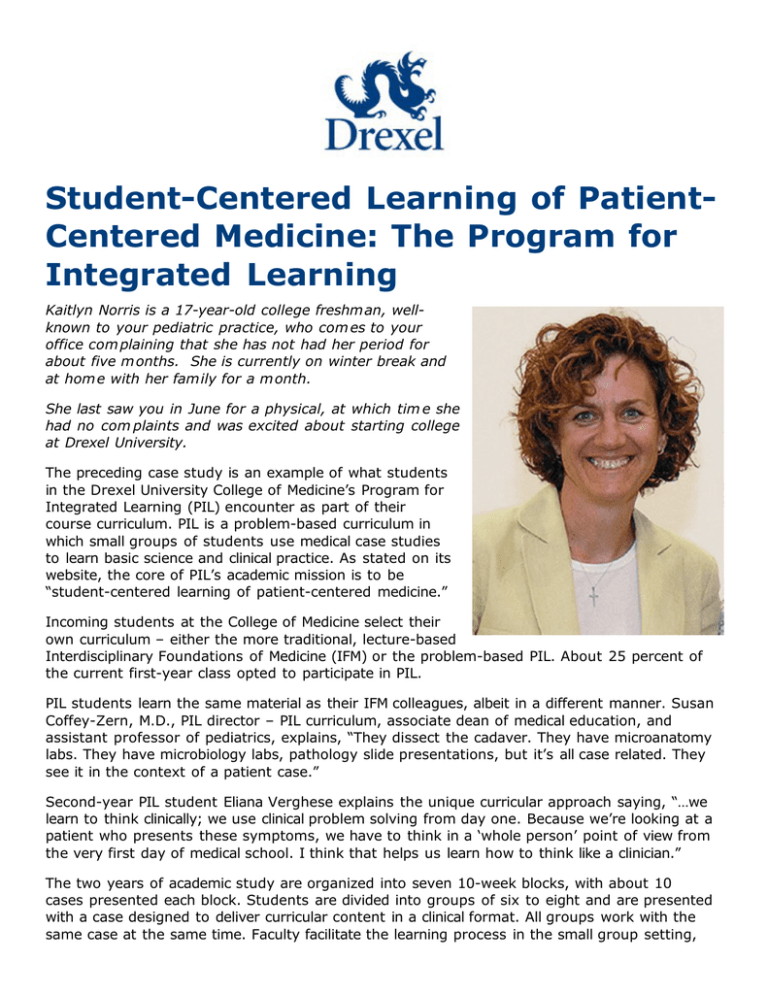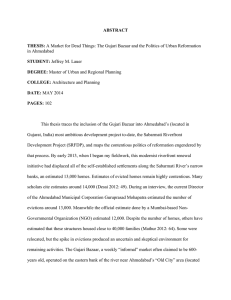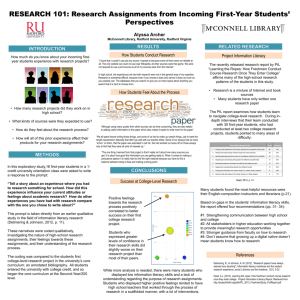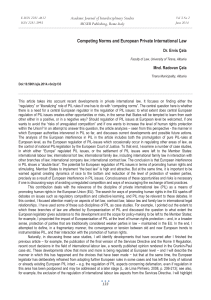Student-Centered Learning of Patient- Centered Medicine: The Program for Integrated Learning
advertisement

Student-Centered Learning of PatientCentered Medicine: The Program for Integrated Learning Kaitlyn Norris is a 17-year-old college freshm an, wellknown to your pediatric practice, who com es to your office com plaining that she has not had her period for about five m onths. She is currently on winter break and at hom e with her fam ily for a m onth. She last saw you in June for a physical, at which tim e she had no com plaints and was excited about starting college at Drexel University. The preceding case study is an example of what students in the Drexel University College of Medicine’s Program for Integrated Learning (PIL) encounter as part of their course curriculum. PIL is a problem-based curriculum in which small groups of students use medical case studies to learn basic science and clinical practice. As stated on its website, the core of PIL’s academic mission is to be “student-centered learning of patient-centered medicine.” Incoming students at the College of Medicine select their own curriculum – either the more traditional, lecture-based Interdisciplinary Foundations of Medicine (IFM) or the problem-based PIL. About 25 percent of the current first-year class opted to participate in PIL. PIL students learn the same material as their IFM colleagues, albeit in a different manner. Susan Coffey-Zern, M.D., PIL director – PIL curriculum, associate dean of medical education, and assistant professor of pediatrics, explains, “They dissect the cadaver. They have microanatomy labs. They have microbiology labs, pathology slide presentations, but it’s all case related. They see it in the context of a patient case.” Second-year PIL student Eliana Verghese explains the unique curricular approach saying, “…we learn to think clinically; we use clinical problem solving from day one. Because we’re looking at a patient who presents these symptoms, we have to think in a ‘whole person’ point of view from the very first day of medical school. I think that helps us learn how to think like a clinician.” The two years of academic study are organized into seven 10-week blocks, with about 10 cases presented each block. Students are divided into groups of six to eight and are presented with a case designed to deliver curricular content in a clinical format. All groups work with the same case at the same time. Faculty facilitate the learning process in the small group setting, and experts provide guidance in basic science content through lecture-type meetings known as resource sessions. At the end of their first year, in Block IV, PIL students also participate in the Primary Care Practicum. In this highly unique experience, students spend six weeks in a primary care practitioner’s office. Israel Hopkins-Green, M.D., a second-year pediatric resident at Children’s Hospital Boston and PIL alumnus, explains, “If you’ve ever seen medical rounds…essentially what it turns into is a group discussion, to a certain extent, on the patient…. That’s very similar to what it is in the PIL program….” The PIL cases also serve as a way to integrate the academic curriculum in a more hands-on or experiential format. Dr. Coffey-Zern explains that this type of learning greatly appeals to students. “It very much mirrors the way a practicing physician would think. They can see why they’re learning what they’re learning…. When you’re learning the anatomy of the limbs, you’re learning it in the context of why you need to know it as you need to practice medicine. Instead of hearing it in a lecture, you’re seeing a patient come in with a problem. You’re seeing how the physician would treat it, why it’s important to know the details of the anatomy.” In this problem-based or case-study model, the patient is at the center of the student’s entire epistemology. Ms. Verghese says the groups address “patient as a person” issues in every case. They are trained to ask questions about the individual’s background and home life to determine how other factors might be contributing to their case. She elaborates, “Each patient that comes into an office has different psychosocial issues that may not be directly related to exactly what their diagnosis is, but it directly affects how we can treat them…. Does our patient have insurance coverage, and how does this affect whether we might be able to treat them in a primary care setting versus in the ER? Or does the patient have some other compounding factor, like substance abuse, or is this something that is occupationally related? We look at this person like they’re not just a science case.” This patient-centered curricular model translates to clinical practice as well. Dr. Hopkins-Green explains that, “PIL gives you this opportunity to sit down for a relatively long period of time and think about a patient’s whole picture. You spend a lot of time in PIL…thinking about a clinical problem. When I see a patient with a specific clinical problem I often still spend a good amount of time reflecting on the problem as opposed to just jumping into a diagnosis quickly…. [Especially] for more complicated patients it definitely rings true that PIL has helped me out with that.” The purposeful diagnostic process that Dr. Hopkins-Green describes can be seen as directly stemming from PIL’s small group dynamic. The facilitator plays a critical role in this process. Dr. Hopkins-Green, himself a co-facilitator (or preceptor) during a fourth year medical education elective, says, “The job of the facilitator is not to give the answer but to push the students involved into finding the answer through individual research methods or as a group.” PIL facilitators provide an essential resource for the small groups and are a vital part of the learning and collaborative process. This position is filled by clinicians as well as Ph.D.’s. Dr. Coffey-Zern explains that some facilitators participate between working in their own clinical practices. “They love it,” she says. “It’s a great way to have interactions with the preclinical medical students. Also, [they can] still do their practice and…their clinical time as well. So it’s a great way to be part of the medical education at Drexel. But it doesn’t necessarily have to be that you’re a Drexel employee.” In fact, Dr. Coffey-Zern sees PIL as a wonderful opportunity for alumni to become involved with the College of Medicine. “We would love to have people come back and be part of Drexel.” Alumni across the country can also interact with current students by serving as preceptors for the Primary Care Practicum. In addition, facilitators mediate the group dynamic, ensuring that each member is contributing to their potential. Ms. Verghese confirms that there is a high level of personal responsibility and accountability within the groups. “We’ve all worked really hard to get here. We all want to be here…there’s definitely a high level of professionalism within the group,” she says. The groups and facilitators change after every block, allowing students to further develop their interpersonal skills. Ms. Verghese explains that this dynamic is one of PIL’s strengths. “There are definite personalities in different groups that may not mesh well with yours,” she says. “But it’s all about learning how to deal with those situations because, ultimately, in professional situations we’re going to come across lots of different types of people, and we’re not going to get along with everybody. So it’s a really safe environment in which to learn how to maneuver those kinds of situations and come away with a stronger ability to roll with the punches.” Dr. Hopkins-Green believes that the small group dynamic essential to PIL has given him a tremendous advantage as a physician. “Clinical medicine is dependent on teamwork to a certain extent,” he says. “PIL does peer feedback…right from the start. It’s mandatory. You’re taught…how to receive feedback, too, and how to think about constructive feedback given to yourself…. I’ve seen a number of residents and medical students and doctors who either aren’t very good at feedback or don’t necessarily know how to receive good feedback. It’s really something that….PIL starts doing early on and really tries to teach you the fundamentals and theories about how to do it.” Indeed, PIL’s goal of “student-centered learning of patient-centered medicine” seems to be thriving. The case-study model necessitates that students become their own educators, yet always keep the patient at the forefront of their diagnostic process. “I really like the way the program is structured from an academic standpoint,” observes Ms. Verghese. “I think it’s a great way to learn. [Talking] about material is so helpful in terms of solidifying your understanding. It’s not like you’re just looking at a page, hoping that you’re absorbing it…. Teaching another [person] is one of the hallmark ways to ensure that you understand something well.” The Program for Integrated Learning began in 1991, designed by faculty who visited medical schools across the nation and created a type of “best practices” model for the College of Medicine. Dr. Coffey-Zern explains that the program has evolved over the years to incorporate changing technology and medical advances. While other medical schools have problem-based programs, not many have anything like PIL’s curriculum. Dr. Coffey-Zern says the other medical schools “…will have the students go in small groups and do one case once a month. A lot of schools will say they do problem-based learning, but our curricular track is dedicated to this.” Fortunately, there are also answers in this problem-based learning model. Remember Kaitlyn Norris, the 17-year-old college freshman from the PIL case study? While working through her case, PIL students learned about endocrine physiology, eating disorders, and that Kaitlyn has a craniopharyngioma. For m ore inform ation about getting involved with PIL as a facilitator, please contact Dr. Susan Coffey-Zern at: 215-991-8550. © Copyright 2013 - Drexel - All Rights Reserved.







